Have you noticed the skyrocketing rate of homelessness that keeps growing since Obamacare and other harmful systems drain jobs, money, and energy from the economy?
Once the final blow comes that spells the beginning of large scale social collapse, the ability to find a shelter will be as scarce as food and water supplies.
Many preppers think they will be able to get into the woods and build shelters or find some other means to avoid living exclusively outdoors. It will be even worse: a sheer number of problems might lead to illness and disability that will prevent you from building or effectively managing an existing shelter.
You don’t believe you may wind up homeless and disabled so you still need to know how to stay warm when you have no shelter and can’t build much of a fire.
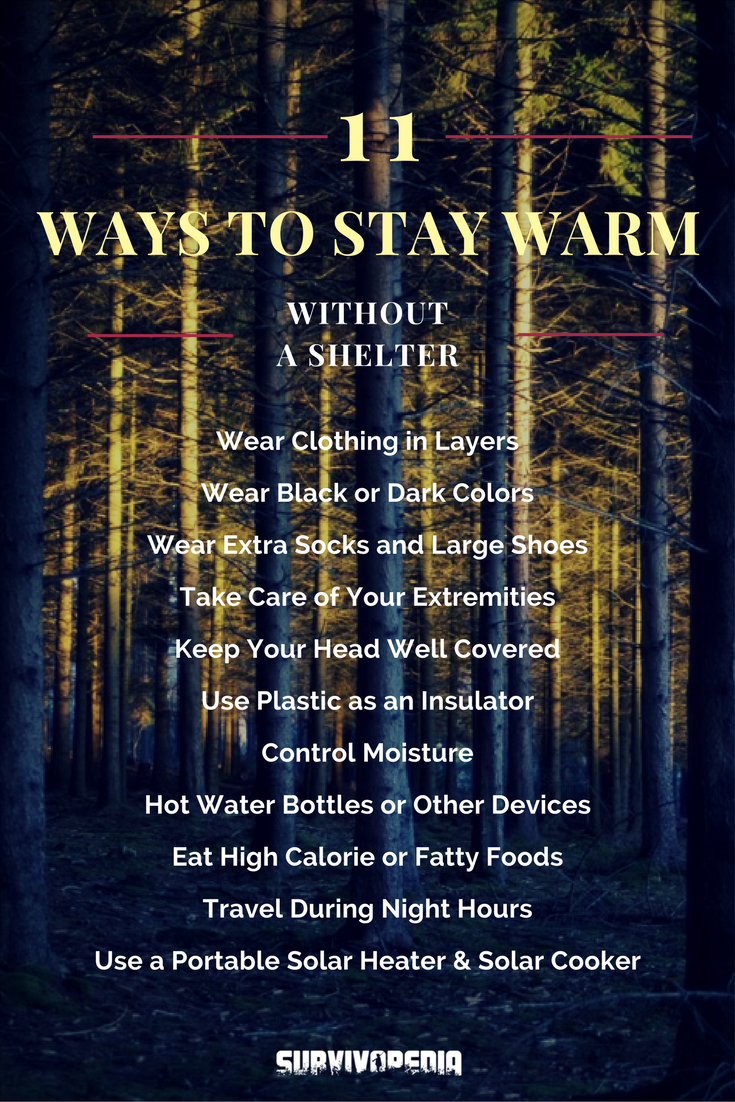
Wear Clothing in Layers
When you know it is going to be cold, you may be tempted to wear the heaviest garments you can find, thinking that weight and dense fabric equate to warmth. On the other hand, the best way to keep heat close to your body is to have more air pockets that within the clothing itself.
Wearing clothes in layers gives you better air pockets than wearing just one thick garment.
When layering your garments, choose materials that wick moisture away from your body for the innermost layers. This will enable moisture to be pulled away from your skin, which will reduce the amount of cooling caused by sweat and evaporation from your skin.
Materials in the outer layers should focus more on acting as windbreakers and moisture blocks. Plastics, vinyl, or other non-permeable materials will work well for the outermost layer.
Make sure the outermost layers are large enough to leave some air space between each garment. Remember, you are aiming to keep warm trapped near your body, not simply press a bunch of garments together in order to mimic thicker fabric.
Wear Black or Dark Colors
No matter what you are doing, black, or dark materials will absorb heat and radiation while white or shiny ones will deflect it. Typically, when it is cold, wearing dark colors will enable the fabrics to absorb heat from the sun or any other source of heat that reaches you.
Wear Extra Socks and Large Shoes
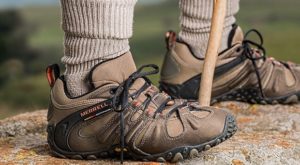
As with layering your garments, the best way to keep your feet warm is to wear layers of socks.
Once again, you will need to choose socks that wick better for the inner layers. This will reduce the risk of foot infections from excess moisture as well as help keep your feet warm and comfortable.
Until you’ve walked several miles on a daily basis, you may not realize that bigger shoes truly are more comfortable than ones that seem to “fit just right”. Always look for shoes that have a little extra room in the toes and around the widest part of your foot.
Larger shoes give you more room to layer socks, and they will also reduce problems associated with callouses and foot cramps. If you find that you have too much room around your ankles, just go ahead and wrap them in some fabric and put a brace behind your heels.
Pay Attention to Your Extremities
No matter how warm you manage to keep the core of your body, your arms, legs, hands, feet, and head are going to feel cold a lot faster. These are also the parts of your body that will develop frostbite fastest, so keep them as warm as possible.
To keep temperatures more, slip something thin and flexible into your gloves and shoes that will retain heat. This may be as simple as tin foil or anything else that warms up quickly and can be reused with little effort.
You can also use layers of fabric, plastic, or vinyl to keep heat in as much as possible. Just remember, though, for hands and feet, you may need to loosen the plastic from time to time in order to let moisture escape.
Keep Your Head Well Covered
Fur and hair are both excellent insulators, but on the other hand, as an extremity, your head is also an area of your body where you will lose a lot of heat.
Here are some inexpensive things you can do to prevent heat from escaping from your head and neck area in cold weather:
- Wear a hat with a face mask that you can tuck into the neck area of your innermost garments, to keep the heat close to your body and also help redistribute it if needed. You can easily knit or crochet a hat like this and make it custom fit for your needs.
- The outermost shell of your garments should have a hood that can be used as a wind breaker and water barrier.
- Make sure you can cover your nose and mouth to keep them as warm as possible. A black towel or anything else that will keep the cold out can be used for this purpose. You’ll need to leave some openings for ventilation, but you can still reduce heat loss by arranging the garment folds to keep most of the heat near your face.
Use Plastic as an Insulator
Anything from plastic grocery bags to trash bags and even plastic table cloths can all be used as insulators. When using plastic as an insulator against the cold remember to:
- Choose plastics that are as durable as possible. Even though smaller sized trash bags may be cheaper, the larger construction strength bags are almost as heavy as black plastic commonly used for killing weeds. Heavier plastic will last longer and develop fewer weak points created as you move around.
- Use black or other dark colored plastic as it will help retain heat from the sun or any other external source that you can find.
- Make sure that you can vent moisture easily from the plastic on a routine basis without losing heat. For example, if you have a flat sheet of plastic, arrange the layers so you can loosen different areas easily and let the moisture out from them without losing heat in other areas.
- Avoid using tape or anything else that will pull on the plastic or create holes when you have to loosen the plastic. If you do need to secure the plastic, use light weight rope or even yarn to form a seal between the plastic and your inner garments.
- Avoid using plastic right next to your body because water evaporation from your skin can spell disaster and lead to both skin infections and increased risk of frost bite.
Control Moisture
Even though wearing layers of garments can help with moisture control, you should also know what parts of your body are going to sweat the most and cause problems.
For example, if you sweat a lot between your shoulder blades or tend to have sweaty feet, you must always pay extra attention to these areas. Among other things, you can try using an extra towel in these areas, and then change it out every few hours for a dry one.
Avoid using chemical antiperspirants as they can easily irritate your skin even more. They also may not be easily replaced, which will leave you with another problem on your hands. If you are dealing with a social collapse or a scenario where you cannot buy something to replace what was used, chemicals like this will be a waste of time.
Hot Water Bottles or Other Devices
When it comes to retaining heat, few materials absorb it or hold it as well as water. Therefore, hot water bottles offer a good way to retain heat near your body and also store any heat you can get from an external source.
A hot water bottle can serve to keep you warm and also meet other needs. In particular, today, you can buy a batch of collapsible, clear plastic, flexible water bottles that can be used to store water and also purify it. All you have to do is leave the bottles in the sun and let them heat up.
If the weather is especially cold, use a cardboard solar oven to increase heat capture. Once they are warm enough, simply insert them into different layers of clothes. Since you can buy different sized bottles, it is possible to find ones that will suit your needs.
Balloons will also work in a pinch, however, you may not be able to get more than one or two uses from them. They also cannot be used for killing off bacteria in water because UV rays from the sun may not be able to get through the material as easily as they can through the clear plastic.
Eat High Calorie or Fatty Foods
If you have ever been on an extended hike or had to do a lot of physical work in one day, you also increased your caloric intake to meet those needs. Your body uses a tremendous amount of energy when you are out in cold temperatures. Choose foods that your body can turn into energy very quickly, as well as ones that will help you stay warm.
This includes fatty foods as well as ones that are fried. If you are looking for the perfect excuse to eat some bacon, fried chicken, or anything else that is usually off the menu because of caloric concerns, being out in the cold with no shelter is a good excuse!
Insofar as food stores, you can also store away foods high in carbohydrates and consume them at regular intervals.
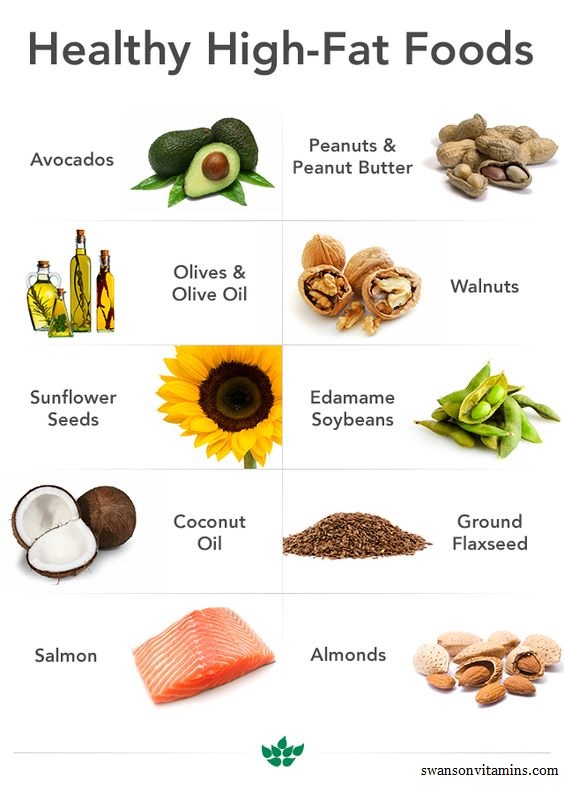
Along with high-calorie foods, drink plenty of water. Even if you are feeling cold or chilly, your body is still doing a lot of work to try and maintain a safe temperature, which means you will be using a lot of water, and also sweating more than you might expect.
Keeping hydrated will prevent you from getting sick and also help you stay warmer as your body will be able to carry out necessary tasks as efficiently as possible.
Travel During Night Hours
As simple as it may sound, traveling during night hours is a simple, cost-effective way to stay warm. Since temperatures are warmer during the day hours, you can use this time to sleep or rest, as the sun and other resources will give you some extra heat.
This is also a good time to stay stationary and heat up water bottles or harness other heat sources that you happen to have come across in your travels.
Chances are you already know that your body temperature drops when you are sleeping. If you are already out in the cold, this can spell disaster. On the other hand, when you are awake and moving around, your body produces more heat. Therefore, when you travel at night, you are producing more heat at a time when less is available from the sun.
Build a Portable Solar Heater and Solar Cooker
No matter how cold it may be, the sun will still rise and provide heat for a few hours each day. Here are two things you can adapt for your needs even if you do not have shelter:
- You can make a solar heater from tin cans and a few scraps of wood and glass. Simply substitute the wood and glass for lighter weight metal and clear plastic, and you will have a portable solar heater. Count on using about 15 – 20 empty cans. You can pipe warm water or warm air in as close to your body as possible. You can use flexible plastic airline tubing (½ inch will work) in the layers of your clothes to transport both water and air, and a battery operated pump for more efficient circulation. If you are in one location during the day, this can truly be one of the most important pieces of equipment you have on hand.
- A cardboard box solar cooker. You can use this device to heat up everything from your dinner and water bottles to bricks and rocks that can be used to retain heat.
When you cannot start a fire and have no shelter, it can be very dangerous for you to be out in the cold weather. While you may not want to think about being homeless or what will drive you to this situation, it is still very important to know how to stay warm without shelter and a fire.
You can devote some of your survival budgets to a set of garments and gear that can be used to keep you as warm and comfortable as possible even when the temperatures are freezing and you have nothing else to work with.
You’ll always find a way to survive if you have the will to practice your skills and prepare for survival!




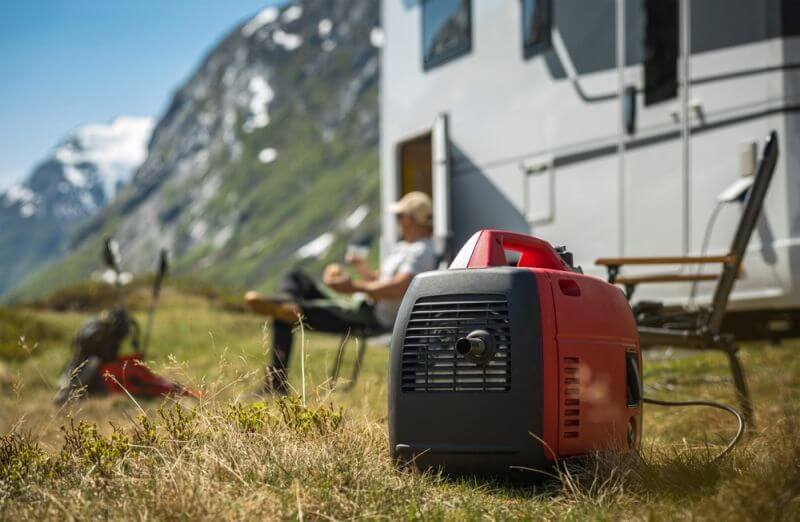
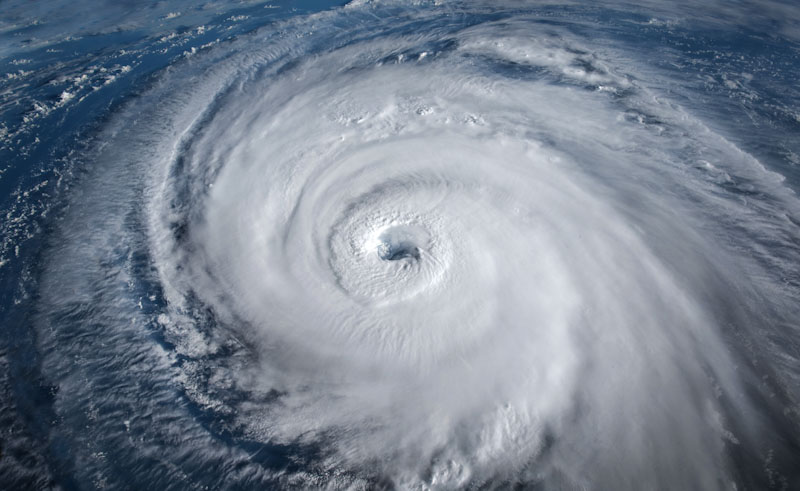


Glen | July 31, 2017
|
An actual description of how to make the improvised solar heater and cooker would be appreciated, or a link to where that information is would work too. Otherwise, good article.
Survivopedia | July 31, 2017
|
Glen, thank you for commenting, and also for the suggestion. We have it on the list, and you will read about it soon on our website.
Bobbi | December 28, 2018
|
YouTube has videos on solar ovens & heaters.
Grammyprepper | August 1, 2017
|
I KNEW THERE WAS A REASON GRANDMA MADE US WEAR BREAD BAGS OVER OUR SOCKS IN OUR WINTER BOOTS AND RUBBERS IN THE RAIN BESIDES STAYING DRY, LOL!
joelfarm | August 2, 2017
|
While not socially acceptable at present, saving your bread bags is one of the cheapest, valuable investment for disaster prepping. 1-turn bag inside out. This will both clean it of leftover bread product and ready it for use. 2-Fold or simply crumple it up tightly taking as much air out as possible. 3-Store as many as possible in Sturdy container. I use large wide mouth plastic Jars. As the above posts suggest, these simple bags are useful in wet conditions and most are fairly durable. I have used large bread bags over regular shoes and they have lasted several hours outside as long as common sense is used in walking.
BK | December 28, 2018
|
LOL, finally, someone else who remembers what the “original” “rubbers” were! At work, with younger people around, you should have seen their faces when I said “let me get my rubbers” when I was about to go outside.
Grammyprepper | August 1, 2017
|
ps sorry fort\the all caps, IT WON’T LET ME POST ANY OTHER WAY. i DO NOT HAVE MY CAPS LOCK ON!
Norman Baron | August 1, 2017
|
Agila
Sorry about your all caps Grannyprepper. It is just the government invading your computer. They are coming for all of us. head for the hills.
Prepared Bee | August 2, 2017
|
I couldn’t agree more!
willowa | August 2, 2017
|
‘Traveling at night…’ This depends a lot on conditions and terrain, traveling at night is slower and more dangerous!
Gat | December 28, 2018
|
traveling at night might be slower, but it is less dangerous as you are less visible
William Halford | December 16, 2020
|
Less visible to people that may harm you, yes. But the same thing that makes you less visible to someone else also makes hazards on the ground less visible to you. In my area, I can take off across the desert and there’s a lot of things I may not see at night that can trip me. And there’s also things like the numerous washes and canyons that will need to be crossed in any direction I go. I’ve crossed a few during the day, and it takes good visibility to find the safer places to cross, as well as good visibility to know where to not step while crossing. One tumble, like happened to a friend of mine while walking to a hunting spot just before daylight, could easily break bones and leave you stranded. The only reason he wasn’t stranded is because he was bowhunting, and he had a survival kit with paracord, with which to make a splint. Then he eventually managed to get to where he had phone service. So it’s not necessarily as simple moving at night, as you think.
sally | December 31, 2018
|
night vision for one person in the group helps a great deal, especially when there’s no moon or it’s very cloudy.
Fed up with dumb political correctness | August 5, 2017
|
joelfarm –
Great comments, but you almost lost me when the sentence started “While not socially acceptable at present…”
Have you noticed that all of the places that won’t give you a plastic bag will still sell you as many as you can pay for? garbage bags, sandwich bags, all sorts – as long as you pay for them.
(I’m stuck in “caps world”, too – it wasn’t a choice)
Rusty | August 6, 2017
|
The homeless population has skyrocketed in my area lately and most are easily identified as addicts. They will have a rude awakening come winter. In the service I learned the value of a good pair of socks in winter weather.
Sam | December 28, 2018
|
Exactly. I don’t usually give money, so as to not encourage the life, but not all of them are on the streets by choice. I do hand out new socks I get at Sam’s. No one should have to die for bad life choices.
Pingback:10 Essentials For Surviving In The Wilderness At Night | Survivopedia | August 20, 2017
|
Dr. Luke Prophet | December 28, 2018
|
If America is attacked with nuclear weapons and then invaded, which the Bible says it will be, the best thing to prepare is a four letter word- Flee which the Bible also tells us to do. So where to flee to? Again the Bible tells us there must be a second Exodus from Egypt, so flee to Egypt before you die. Exposure will kill you faster than lack of food and water. It gets cold in the desert in winter, and will get colder with nuclear winter. Bring a tent, ground sheet, and sleeping bag that are all designed for winter use and are all light weight that can be carried on your back. Bring Potassium Iodide pills to prevent Thyroid Cancer from Radiation Poisoning. Bring insulated boots that you can wear with at least two pairs of heavy wool socks. Bring a couple of water canteens, matches in a water proof container, a heavy sweater and insulated pants and jacket designed for winter weather.
Pingback:The Best 10 Tips For Survival Camping In The Rain | Survivopedia | December 13, 2017
|
Pingback:10 Essentials For Surviving In The Wilderness At Night – Weekly Conservative | July 25, 2018
|
Pingback:Top 10 Rules To Follow When Choosing Protective Clothing | Survivopedia | November 5, 2018
|
William Halford | December 28, 2018
|
One thing not mentioned is waterproof shoes. Just walking in grass with dew can soak though most shoes pretty quick, a lesson learned pretty young while growing up in Florida. I prefer a 6″ waterproof hiking shoe. There’s some good, lightweight designs out there. And if there’s snow, 8″. Put the pants legs over the top, and they do good for keeping out snow.
Jerry D Young | December 28, 2018
|
If a person can heat water all, warm drinks will help keep the internal core body temperature up. Especially if the body is well insulated with clothing, blankets, sleeping bag, etc. Adding a flavor to the hot water makes it a bit more palatable, but coffee and tea are not the best choices. Boullion and hot chocolate are better. And with hot chocolate you can add a large pat of real butter and get some of the extra fats that are needed in cold weather.
For those that have and intend to use space blankets be sure to have some other insulation between the space blanket and the body. If the space blanket touches the body it will only transfer the cold to the body. However, even with the space blanket kept away from the body, it must be vented to allow the moisture from the body (and there is a great deal of it coming from the skin even when cold) to prevent soaking everything inside the space blanket.
Best use is to put on down on the ground (or bed of leaves, etc.), add an insulating layer, and then sit or lie down on it. Cover with additional insulation, and then top with another space blanket. Do not tuck in the space blanket to the degree that prevents at least some air movement to vent the moisture. With the body heat reflected back from the space blankets below and above and kept close to the body with the other insulation, a person can stay pretty warm by consuming the foods listed in the article and drinking a hot drink from time to time.
Just my opinion.
Nona Urbiz | January 1, 2019
|
You can also put grass in your shoes to help insulate and warm your feet.
Danny joe | January 2, 2019
|
I tried putting grass in my shoes, but those damn drug dogs at the airport wouldn’t leave me alone. :). Just kidding.
Sam | January 2, 2019
|
Grass was probably the first insulator. But if you put it in your shoes, be sure it is DRY grass. It works well stuffed in your jacket, or even in your pant legs, but moving around will crush it in your shoes. You don’t want damp socks. But that is an excellent point, Nona. Use what is around you.. If you have grass, use it. If you are in the concrete jungle, use cardboard, or newspaper.(Take care with the ink, tho’. Whatever you use, remember the rule. Layer up, don’t pack it down.